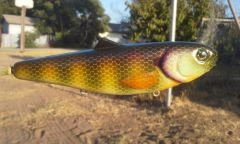Search the Community
Showing results for tags 'solarez'.
-
Hello TU clan. Thanks for all the groundwork and experiments you guys have done. Soo much great information. So here she is, my first posted bait. Not my first bait. I used to make a ton of triple trout clones by pouring epoxy. Here is how she was made. PVC board blank hand carved, Foil finish tec...
-
Guys have different criteria regarding topcoats. For me, durability and ease of application are the most important things. Solarez is quick, durable, and yields a satin gloss topcoat unless you buff it out mechanically to a high gloss - which I don't go to the trouble of doing. Satin is OK by me....
- 33 replies
-
-
- bluegill pattern
- createx
-
(and 1 more)
Tagged with:







